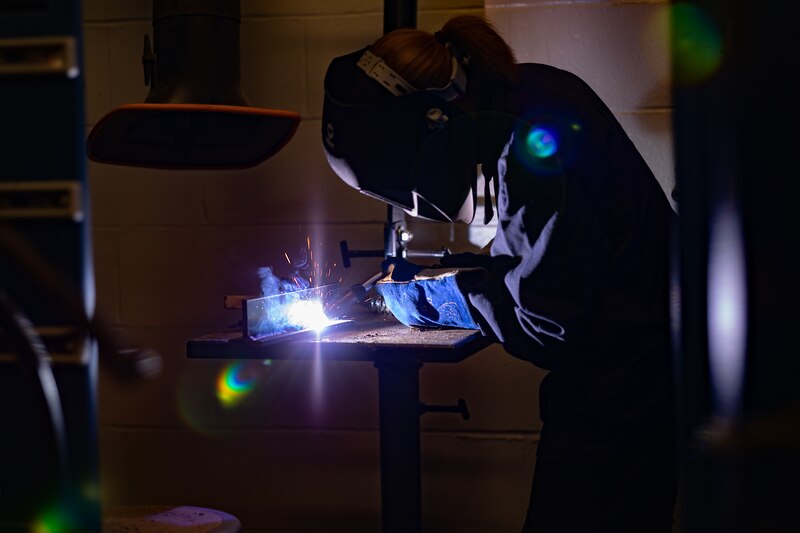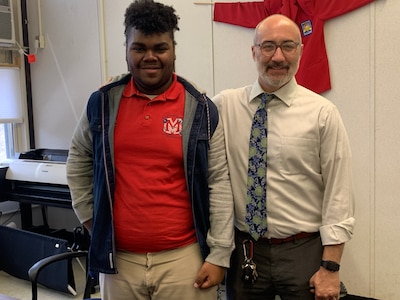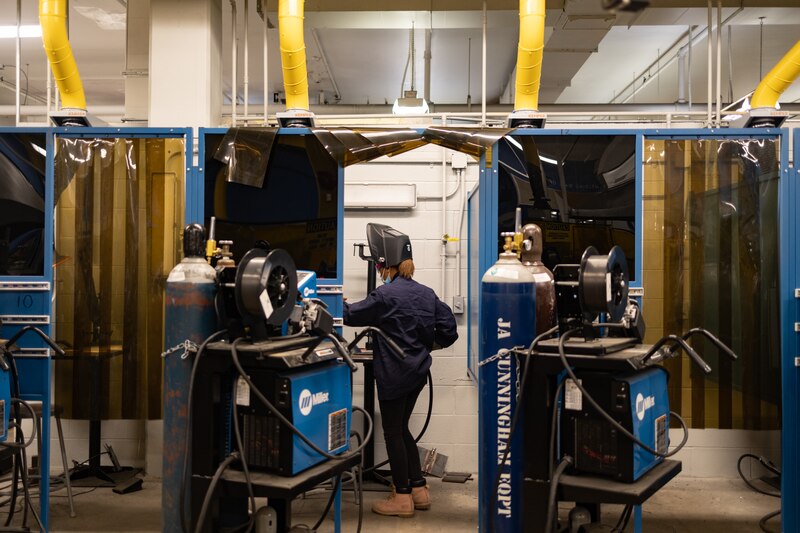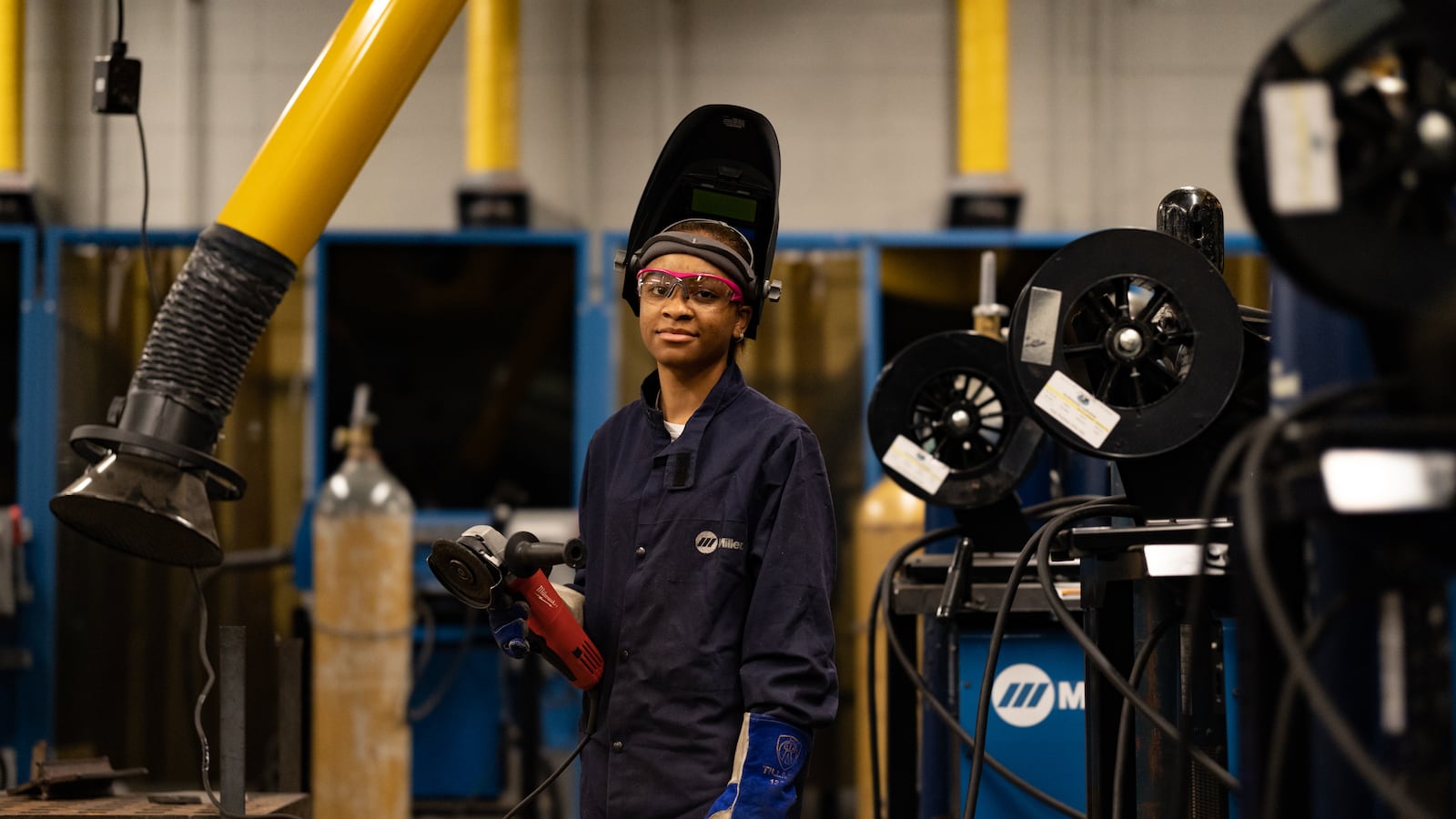Ahjhané Blackwell prepared herself for a big speech marking the start of a career in welding that, a few years ago, she had no idea she’d want.
It was signing day, and she was among 11 graduating seniors from Philadelphia district schools, and 200 from southeastern Pennsylvania, who were committing to their future employment with local industries in a ceremony at the Independence Seaport Museum.
All of them landed apprenticeships or jobs right out of high school through the Talent Pipeline Project, a partnership between Pennsylvania school districts and the local defense industry that has a huge presence in the Philadelphia region.
The project is part of a concerted effort to more precisely tailor the school district’s extensive career and technical education program — in which students can choose from among 43 specialties — to both local workforce needs and student interests. The heir to “vocational education,” which often became a dumping ground for less academically able students, many CTE disciplines today are highly rigorous and in demand among students seeking good-paying jobs while avoiding college debt.
“It was always viewed as a program for those who ‘can’t, won’t, and don’t,’ for those not going to college and don’t want to,” said Michelle Armstrong, executive director of CTE at the district. “But what has transpired through the years is a recognition that this is not what this is. We view CTE as giving our young people options.”
Students in CTE specialties graduate at higher rates than non-CTE students, according to the most recent Philadelphia data. At same time, getting on the CTE track is far from a guarantee of well-compensated employment right out of high school, according to student surveys.
In a survey of all seniors who graduated in 2021, fewer than one-fifth of those in CTE reported going directly to a job, similar to the number for non-CTE students. And many students aren’t sure if their CTE pathways have led to the right certification for immediate employment.
Welding “came naturally to me,” Ahjhané told the gathering of dignitaries from several companies, the school district, and the military at the Seaport Museum. The ceremony, complete with color guard and singing of the national anthem, was meant to mimic signing days where star high school athletes announce their college choices.
Like the athletes, some of these students received offers from several companies, and this was their chance to commit. As each student’s name was called, their name and company flashed across a big screen.
Upon graduation later this month, she is headed for a job with Rhoads Industries, which does industrial fabrication, installation, and maintenance, especially for ships. At Rhoads, she hopes to be a torch welder, which relies on heating metal to meld pieces together.
“I’ve always been a hands-on person. I never did anything that required more concentration, perseverance, and patience,” she said.
A steady expansion of CTE offerings
Ahjhané studied welding at Randolph Skills Center, although that wasn’t her plan at first. She previously wanted to be a dental assistant. And she had no female role models for welding.
But the welding teacher at the time, Joe Williams, laid out clear benefits of entering that line of work.
“For one thing, I wouldn’t make nearly as much as a dental assistant,” she said he told her.
She developed her skills despite having to spend an entire school year without any hands-on experience during the pandemic. Instead, she watched YouTube videos to help her visualize the process.

The 43 CTE pathways students can pursue in Philadelphia district high schools are divided into 10 career clusters. These pathways include everything from automotive repair, baking, and carpentry, to early childhood education, graphic design, and precision machine technology. They’re available to students in both dedicated vocational schools and many neighborhood schools.
The district’s CTE offerings, said Philadelphia Superintendent William Hite at the signing ceremony, “provide a direct link between what they are learning in the classroom and the needs of the labor market.”
The most popular programs in the district are health-related technology, digital media production, sports marketing, and culinary arts.
The concerted effort to align what is taught in CTE programs with industry needs has not always been a district priority; historically, there were times when the auto shops, for instance, had students working on obsolete engines. District officials told City Council members last month about their plan to conduct an outside evaluation of all CTE programs in the 2022-2023 school year to make sure they are up to date, attract student interest, and teach the skills local companies want.
That review will take place as opinions about career training and education continue to evolve. For a long time, students in “voc-ed” tracks were not required to take rigorous courses – instead of algebra, for instance, there was “construction math.” But about two decades ago the Board of Education required CTE students to take all the same academic courses as other students. And since then, more CTE programs and concentrations have been added, such as advanced manufacturing and precision machining at Benjamin Franklin High School.
“We made the decision that if a student chooses to have a CTE pathway, they don’t get a lesser education than their colleagues,” Armstrong said. “They have the same exact graduation requirements, and they take the same classes. They are prepared to go to college, if they want to. They can go into the world of work. Or they can do both.”
Recent data shows that local students on the CTE pathway are more likely to graduate high school than their peers. In Philadelphia district schools, 93% of students who take CTE courses from 10th through 12th grades graduated on time in the 2020-21 school year, compared to 80% who did not take any CTE courses, a district report found. In many of the trades offered, they can earn industry certifications that make them job-ready. And they are still prepared for college if they so choose.
“You can see evidence of the shift in the growth and investment post-secondary institutions are making in CTE,” Armstrong said.
Community College of Philadelphia, for instance, is scheduled to open an entire new advanced technology center in West Philadelphia this fall.
CTE students get certification in their specialties by taking the so-called NOCTI (National Occupational Competency Testing Institute) exam, which are offered in a range of CTE specialties. Overall, 60% of district students who take the tests passed them, according to district data for the three years prior to the pandemic. Some students take multiple certification tests; welding has five, for example.
‘You have to be way smarter’
One of the smallest and newest CTE programs in the district is precision machine technology, which has a program at Benjamin Franklin High School.
Warren Crosby originally wanted to go to an academic magnet school, but says that learning advanced machining at Franklin was a great decision. He and his classmates take pride in their knowledge and ability to help construct essentials that people need and use every day, from bridges and buildings to airplanes and toasters, all of which need to be correctly made in order to be safe.
“Precision machining in its own way is not a bad route at all. I can make almost anything in the world,” Crosby said. A graduating senior, he is headed to an apprenticeship at the Naval Foundry and Propeller Center.
His classmate Caleb Matthews, headed to the same company, is equally enthusiastic about his choice.
“We have to be more educated at an academic level to learn CTE. You have to be way smarter,” Matthews said. Once they complete their apprenticeships by passing several tests of their skills, they will be able to earn more than $30 an hour.
Mastbaum Area Vocational Technical School, located in Frankford, is one of the three original vocational high schools in the city; it historically focused on the construction trades. But it has branched out to offer other specialties, including graphic design, nursing, and culinary arts.

All students are required to choose a specialty once they sample different options during ninth grade. Then they focus on that specialty for the next three years and 1,080 hours of instruction, in addition to a regular academic course load. There’s no more “construction math.”
“It’s intense. We have the same expectations of them” as other students, said David Lon, principal of Mastbaum and a former English teacher.
When he worked at neighborhood high schools, Lon said, “I would see well meaning kids, good kids, sitting at graduation who couldn’t see a path forward. They never had a focus in high school, a discipline they studied.”
One other benefit for students who go straight from the district’s CTE path into the labor force: They avoid accumulating college debt.
“Our alums come back, they are working jobs at PECO (Philadelphia Electric Company, the local electric utility), and at 20-21 years old are buying their first house,” Lon said.
Finding direction and full employment
Not every student who focuses on a trade in one of the district’s CTE programs follows through and gets a job in their specialty.
In the survey of the 2021 graduating seniors, about a quarter of the district’s students identified as CTE students, and most of them, like their peers, said they planned on continuing their education.
Only 17%, compared to 15% of non-CTE students, said they planned on going straight to employment. And 55% of the CTE students said they weren’t sure whether they had earned an industry certification in their field while in their respective programs.
Yet statistics don’t always capture the ways students feel they benefit. Justin Brown is a Mastbaum senior who benefited from the program’s rigor. Also a welder, he said he chose to travel to Mastbaum from Juniata, at least a half-hour trip, because an older sibling went there. Taking up a trade gave him some direction, he said.
The requirement to focus on a trade or specialty “is really preparing you for the outside world,” Justin said.
He has an apprenticeship lined up at the Philadelphia Naval Shipyard which, like Ahjhané, he accessed through the Talent Pipeline Project.

Rhoads, where Ahjhané will work, is one of 50 companies that are involved in the partnership. Its experts work with teachers to make sure students have the right skills. It hired five apprentices from Philadelphia this year, including Ahjhané.
“It’s a symbiotic relationship,” said Trish Conti, a Rhoads spokesperson.
Ahjhané hopes to test out of the apprenticeship at Rhoads to full employment within two months. Normally, it would take two years. Her teacher, David Poe, said he would not be surprised if she was able to do it, and called her a natural.
In her speech before the signing day crowd, she demonstrated the cool demeanor that welding demands.
“Every weld is a challenge,” Ahjhané said. “And every challenge is an opportunity to grow.”
Dale Mezzacappa is a senior writer for Chalkbeat Philadelphia, where she covers K-12 schools and early childhood education in Philadelphia. Contact Dale at dmezzacappa@chalkbeat.org.

